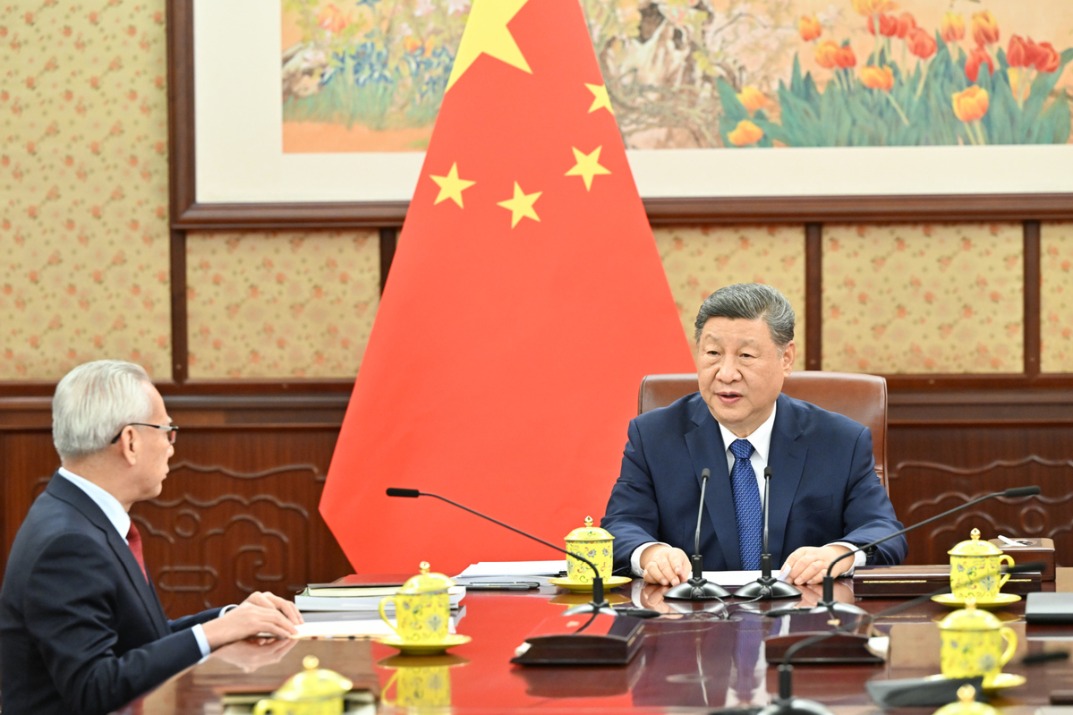Minimal set, maximum impact
Chinese stage adaptation of French novel invites actors to innovate, and audiences to explore unspoken depths, Chen Nan reports.
By Chen Nan | CHINA DAILY | Updated: 2024-12-30 08:55

A wooden table stands in the center of the stage, with a few sheets of paper scattered across it. A single chair is placed across from the table, and books are stacked in the corners and strewn across the ground. The dim lighting and flickering fireplace reveal a slightly unkempt bed occupying the back of the stage.
When the Beijing People's Art Theatre introduced its upcoming production of the Enigma Variations, a Chinese adaptation of the 1996 novel by French author and dramatist Eric-Emmanuel Schmitt, the theater presented a glimpse of the stage set, which is minimalist yet rich in symbolism, and reflects the production's themes of isolation and introspection.
The play, which is being staged at the Cao Yu Theater until Jan 12 and features Feng Yuanzheng and Yan Nan in the leading roles, revolves around the dialogue between two men. One, the Nobel Prize-winning author Abel Znorko, lives on an island in the middle of the Norwegian Sea, and is haunted by the memory of a woman he loved passionately, and with whom he corresponded for many years. The second, a self-proclaimed journalist named Erik Larsen, arrives to interview Znorko about his latest book, which is, in fact, a transcript of his correspondence with the woman. As Larsen seeks to uncover the identity of the woman, Znorko becomes infuriated. His evasions and lies twist into increasingly complex puzzles.
"Unlike other plays we have done, which are narratives driven by storytelling, Enigma Variations is dialogue-driven," 47-year-old director Xu Ang said in an interview on Dec 21. "This structure, with the two characters interacting in a confined setting, depicts the process of deciphering a puzzle. The audience follows the conversation in an isolated environment, which intensifies the philosophical and psychological tension between the two men. There are many questions waiting to be answered: Is Larsen really a journalist? Is it possible that both Znorko and Larsen loved the same woman? Is she still alive?
"There are many dramatic turns in the production, and as a director, I wanted to bring them to life onstage and be understood by the audience. For the two actors, it is quite challenging because of the large amount of dialogue. In their performances, they must touch on universal themes that resonate with the audience," Xu adds. "As for the audience, they will ask themselves questions, and I hope they enjoy the mystery."
Established in 1952, the Beijing People's Art Theatre is a bastion of Chinese drama that has nurtured a number of acclaimed actors and upheld a legacy of excellence and dedication. The theater is known for Chinese-language plays, especially realistic productions focusing on Beijing's culture, society and language. It also produces adaptations of Western literature and invites international theater companies to perform.
According to Feng, who is also the president of the Beijing People's Art Theatre, the idea of creating a Chinese adaptation of the Enigma Variations dates back to 2008, when Xu was first chosen to play the role of Larsen. For a number of reasons, the production was delayed.
"Schmitt's writing style is elegant and thoughtful, and weaves philosophical insight with an exploration of human emotion. The structure of the script, with its layered conversations and evolving revelations, creates a sense of unfolding mystery. We are excited that we can finally bring it to life onstage, closing 2024 and beginning 2025," says the 62-year-old Feng, who plays Znorko.
"Over the years, Xu Ang has evolved from a young actor to theater director. He has watched many theatrical adaptations of the novel and developed his own interpretation that explores the depth of the characters' interactions," Feng adds.
He says that as an actor, he wanted to break free from his usual style. The novel's rich inner monologues and introspection are challenging to convey onstage but the adaptation balances these elements by focusing on the verbal exchange between the characters and using symbolism to represent the deeper themes.
























